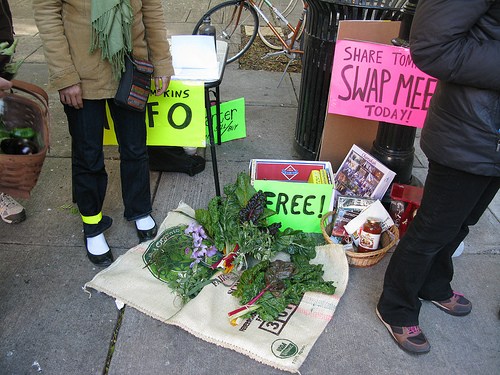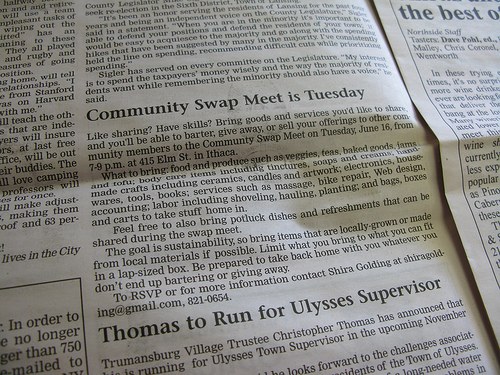We all have something to offer and needs to fill. The more we can provide for each other locally, the closer we are to sustainability.
Share Tompkins, a volunteer-run group based in Ithaca, NY, was formed in May 2009 to help folks share and trade goods and services. We organize monthly “Community Swap Meets,” where people give-away and barter everything from homemade apple butter and original art, to music lessons, and massage.
The swaps are fun, social events and often include potluck food, music and crafting. Our first few gatherings were in people’s homes and backyards. Our most recent Holiday Swap was hosted by a local Community Center and over seventy people came out to share and trade crafts and goodies for the gift-giving season.
This year, we’ve seen Mutual Aid in Motion.
From scaling sharing hubs to Mutual Aid 101 trainings, we’re helping communities build the tools they need.
Every dollar fuels lasting resilience – proving that when we move together, we all move forward.
All kinds of creative arrangements have emerged from these events. At one swap, three different families said they needed help moving. They ended up arranging a three-way swap where they all helped each other on moving day. And another person at the swap lent them his truck in exchange for a hand-knitted hat and gloves. My partner and I have been able to exchange video production and web design for local, organic produce and the supplies we needed to start our own downtown container garden.
Share Tompkins Community Swap Meet #2 from Shira Golding on Vimeo.
You can organize your own Community Swap Meet by following these steps:
Step One: Define your goals. Who are you hoping will participate – people living in your building, your neighborhood, all over your city? What kinds of things do you want to share? You can have a free-for-all, but sometimes it makes sense to focus swaps around clothing, books or some other theme. If you haven’t already, now might be a good time to get other people and/or groups involved – you’re going to need help with the next steps!

Step Two: Choose a venue and date. Based on your vision for the event, choose a day and time that are likely to yield a good turnout. Usually two to three hours is a good length for a swap, but sometimes they evolve into all-night dance parties – you never know. When choosing a venue, consider size, location, accessibility and cost. Possible free spaces include people’s houses, public parks, community centers, libraries and schools. If you don’t have ready access to one of these, who do you know that does?
Step Three: Spread the word. Be strategic – you probably have limited time, so focus your efforts on reaching people where they are. Sometimes all you need is word of mouth. To reach a broad audience you could make a Facebook event page, put up eye-catching flyers around town, send an event blurb to email lists, and even contact your local newspapers and other media outlets. It helps to start a buzz about a month before the swap, and then send a reminder a day or two before the event.

Step Four: Signs and Supplies. Especially for bigger swaps, it’s good to have some easy-to-read signs outside the venue. We made a generic “Swap Meet Today” sign that we reuse each month. It’s also good to set up a welcome table with info and a sign-up sheet so you can stay in touch with people about future events. Folks usually need tarps or tables for their stuff. Sometimes the venue will have these available; if not, ask people to bring their own and/or arrange to borrow some from someone else in the community.
Step Five: Have the Swap! If it’s a smaller gathering, you could start by going around in a circle with each person describing what they brought and what they’re looking for (including services and items that are available but not physically at the swap). For bigger events, we put up “Have” and “Want” boards in a central place with post-its and pens so people can list items along with their name and contact information. We also find its helpful to separate the stuff at the swap into two main areas – “Free” and “For Barter/Sale.” This helps avoid confusion. As for the actual swapping, it seems to work best when people do their own thing and make arrangements organically.
 Step Five and a Half: Document and Evaluate. Take photos and do a head count of how many people show up. Ask people to share their stories of successful swaps as well as feedback on what worked and what didn’t work at the event. Before you plan your next swap, take time to reflect on this feedback and think about what you might want to do differently.
Step Five and a Half: Document and Evaluate. Take photos and do a head count of how many people show up. Ask people to share their stories of successful swaps as well as feedback on what worked and what didn’t work at the event. Before you plan your next swap, take time to reflect on this feedback and think about what you might want to do differently.
Step Six: Keep the momentum going. Follow up with people and organize more swaps and gatherings. Encourage new people to host events and take the lead in other ways. Share what you’re doing online and with local press.
Share Tompkins has organized seven Community Swap Meets to-date and we’re planning a “Really Really Free Market” at the end of January. We also run a mailing list and a website with a directory of over a hundred local and national resources that help people meet their needs.

Beyond all these tangible activities, we feel we are contributing to the creation of a social fabric rich in giving and sharing. At each swap meet, the “Free” section is bigger. It’s not unusual for produce to be left on my doorstep. Before I go to the store, I ask myself, Is this something I can borrow or get from someone in my community and what can I offer them in return? I encourage anyone to take this idea and run with it in your community…for barter or worse!
Visit our site to read our blog, check out photos and videos from events and explore our resources directory or join us on Facebook.

